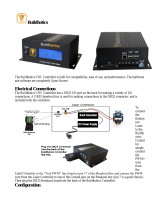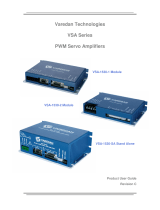
PMAC2 PCI Lite Hardware Reference Manual – Preliminary Documentation
Table Of Contents i
Table of Contents
INTRODUCTION.......................................................................................................................................................1
Overview...................................................................................................................................................................1
Board Configuration..................................................................................................................................................1
Base Version.........................................................................................................................................................1
Option 2: Dual-Ported RAM.................................................................................................................................1
Option 3: USB1.1 Communications Port..............................................................................................................1
Option 5: CPU and Memory Configurations........................................................................................................2
Option 6: Extended Servo Algorithm....................................................................................................................2
Option 6L: Multi-block Lookahead Firmware......................................................................................................2
Option 7: Plate Mounting.....................................................................................................................................2
Option 8A: High-Accuracy Clock Crystal ............................................................................................................2
Option 10: Firmware Version Specification.........................................................................................................2
Option 12: Analog-to-Digital Converters.............................................................................................................2
Option 16: Battery-Backed Parameter Memory...................................................................................................3
HARDWARE SETUP.................................................................................................................................................5
Watchdog Timer Jumper.......................................................................................................................................5
CPU Frequency Control Jumpers.........................................................................................................................5
Re-Initialization Jumper .......................................................................................................................................5
Power-Up State Jumpers......................................................................................................................................5
Firmware Load Jumper........................................................................................................................................5
Flash Memory Bank Select Jumpers.....................................................................................................................5
Encoder Sample Clock Source Jumpers ...............................................................................................................5
Serial Port Selection Jumper................................................................................................................................6
Output Disable State Jumpers ..............................................................................................................................6
Amplifier Enable / EQU Jumper...........................................................................................................................6
Resistor Pack Configuration......................................................................................................................................7
Termination Resistors...........................................................................................................................................7
Pull-Up/Pull-Down Resistors ...............................................................................................................................7
Connections...............................................................................................................................................................8
Mounting...............................................................................................................................................................8
Power Supply Connection.....................................................................................................................................8
Machine Port Connections ...................................................................................................................................8
Display Port..........................................................................................................................................................8
Multiplexer Port....................................................................................................................................................9
I/O Port.................................................................................................................................................................9
Serial Ports...........................................................................................................................................................9
A/D-Converter Port ..............................................................................................................................................9
Handwheel Port....................................................................................................................................................9
COMMUNICATIONS SETUP ................................................................................................................................11
FLEX CPU BOARD JUMPER DESCRIPTIONS..................................................................................................13
E1: Watchdog Disable Jumper................................................................................................................................14
E2: Dual-Ported Ram Port Select............................................................................................................................14
E4 – E6: Power-Up/Reset Load Source ..................................................................................................................14
E7: Firmware Reload Enable ..................................................................................................................................14
E10A, B, C: Flash Memory Bank Select.................................................................................................................14
JUMPER DESCRIPTIONS......................................................................................................................................15
E2: CPU Frequency Select......................................................................................................................................15
E3: Normal/Re-Initializing Power-Up/Reset...........................................................................................................15
E4: CPU Frequency Select......................................................................................................................................15
E5 – E6: (Reserved for Future Use) ........................................................................................................................15
E13 - E14: Encoder Sample Clock Direction Control............................................................................................16
























